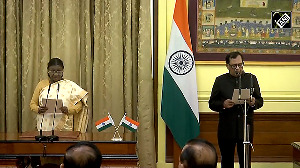The following is the opening Hindu prayer read in the United States Senate on July 12, 2007.
Prayer for the Senate
July 12, 2007
Guest Chaplain
Chaplain Rajan Zed
Reno, Nevada
Let us pray.
We meditate on the transcendental Glory of the Deity Supreme, who is inside the heart of the earth, inside the life of the sky and inside the soul of the Heaven. May He stimulate and illuminate our minds.
Lead us from the unreal to the Real, from darkness to Light, and from death to Immortality. May we be protected together. May we be nourished together. May we work together with great vigor. May our study be enlightening. May no obstacles rise between us.
May the Senators strive constantly to serve the welfare of the world, performing their duties with the welfare of others always in mind, because by devotion to selfless work one attains the supreme goal of life. May they work carefully and wisely, guided by compassion, and without thought for themselves.
United your resolve, united your hearts, may your spirits be at one, that you may long dwell in unity and concord.
Peace, Peace, Peace be unto all.
And Lord, we ask you to comfort the family of former First Lady, Lady Bird Johnson.
Explanation of the opening Hindu prayer read in the United States Senate on July 12, 2007.
Paragraph one (We meditate...) is the Gayatri Mantra from the Rig-Veda, dated from around 1,500 BC, considered the oldest holy book still in common use in the world. In Sanskrit, it goes...
Om
bhur bhavah svah
tat Savitur varenyam
bhargo devasya dhimahi
dhiyo you nah prachodayat
In paragraph two (Lead us...) the first line is from Brahadaranyakopanisad (1.3.28), which in Sanskrit is:
Asato ma sad gamaya
Tamaso ma jyotir gamaya
Mrtyor mamrtam gamaya
The rest of this paragraph two is from Taittriya Upanisad, which in Sansrkit is:
Om saha naavavatu
Saha nau bhunaktu
Saha viiryan karavaavahai
Tejasvi naavadhiitamastu
Maa vidvishhaavahai
Paragraph three (May the...) is taken from (and not the exact translation of) the Bhagavad-Gita (Song of the Lord), the famous philosophical and spiritual poem often considered the epitome of Hinduism. The original in Sanskrit reads as:
tasmadasaktah satatam karyam karma samacara
asakto hyacarankarma paramapnoti purusah (3:19)
karmanaiva hi samsiddhimasthita janakadayah
lokasangrahamevapi sampasyankartumarhasi (3:20)
saktah karmanyavidvamso yatha kurvanti bharata
kuryadvidvamstathasasaktascikirsurlokasangraham (3:25)
na buddhibhedam janayedajnanam karmasanginam
josayetsarvakarmani vidvanyuktah samacaran (3:26)
Paragraph four (United your...) is the last mantra of the Rig-Veda:
samani va akutih
samana hrdayani vah
samanam astu vo mano
yatha vah susahasti (10.191.4)
Last line of the prayer (Peace, Peace) is:
Om Shanti, Shanti, Shanti.
Some of the instructions of the Office of the Chaplain of the United States Senate regarding the opening prayer are:
The purpose of the opening prayer is to seek God on behalf of, and for the Senators. It must be given exclusively and entirely in the English language. Recommended time for the prayer: 1 to 1½ minutes.





